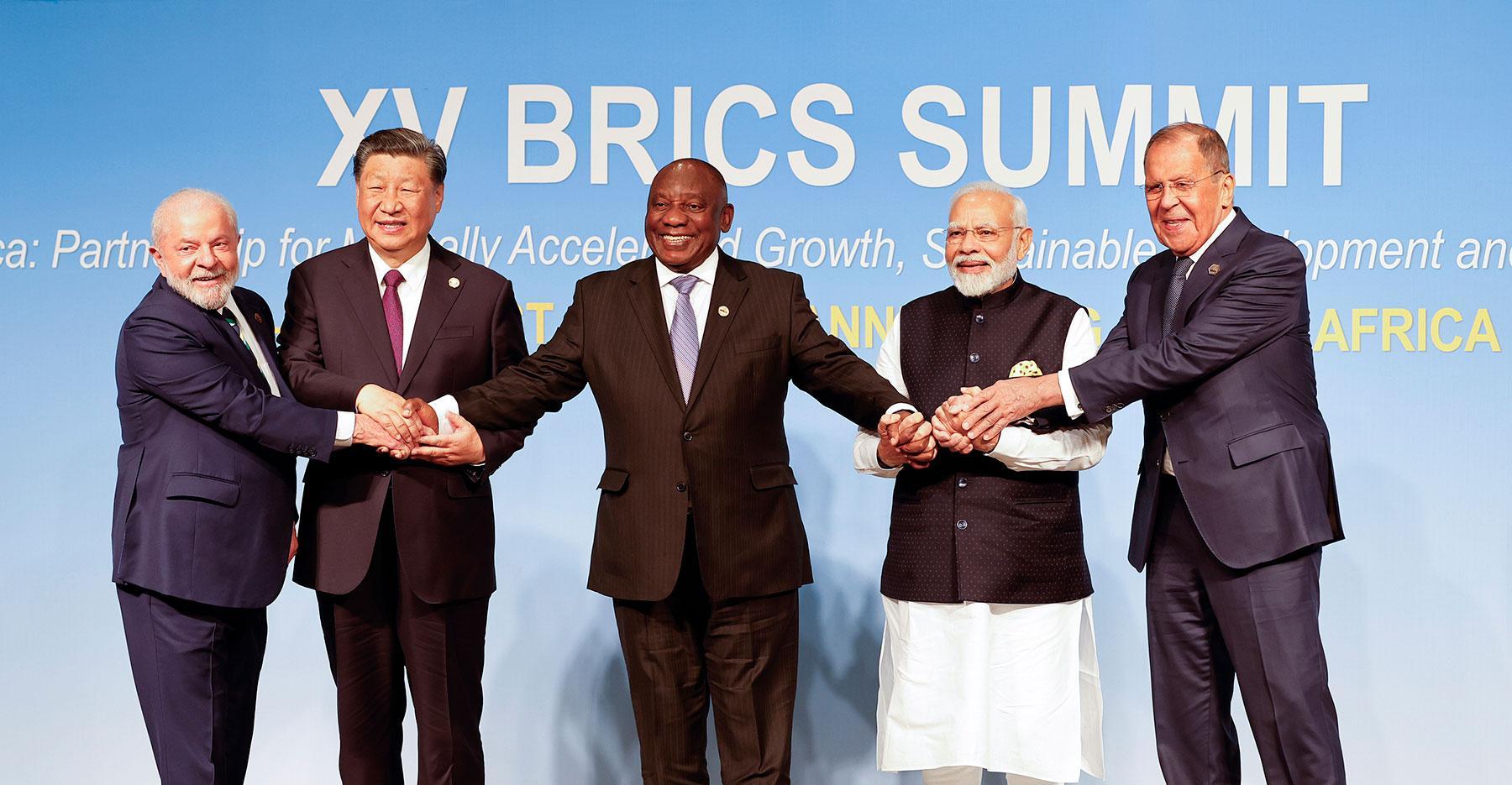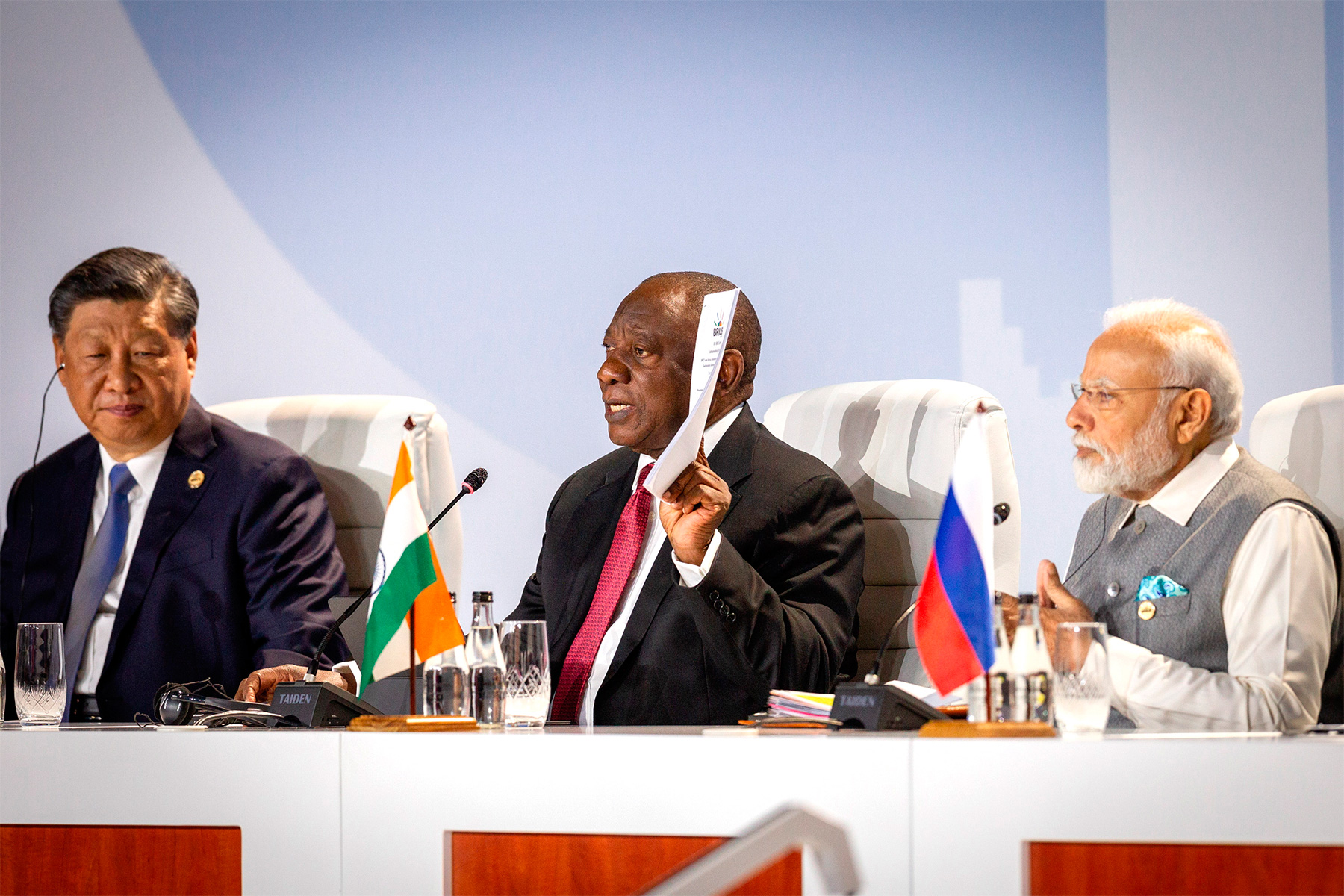Alternative Solutions for Today’s Climate Emergency
In
Login if you are already registered
(votes: 4, rating: 5) |
(4 votes) |
BS, University of Rome, Tor Vergata
Prior to the Sustainable Development Goals (SDGs) initiative, several attempts, such as the Millennium Development Goals (MDGs) and the Kyoto Protocol on Climate Change have been welcomed by the international community, aiming to avoid the irreversible effects of climate change. Despite the ambitious objectives of the signed agreements and preceding cooperation endeavors, significant improvements to the climate emergency have yet to be made. Nevertheless, BRICS members proposed an alternative solution, consisting of South-South cooperation and a three-dimensional framework of sustainable development. Thus, sustainable development is understood as a range of cooperation strategies based on economic, social and environmental factors, followed by the core concept of “common but differentiated responsibilities and respective capabilities” (CBDR-RC). Although some authors [1] argue that establishing successful partnerships are impossible due to contrasting political and economic values among BRICS members, this article argues that a multi-faceted and sustainability-oriented cooperation strategy will prevail over discrepancies in state domestic priorities, mainly due to a unique form of people-to-people cooperation in the larger framework of the Global South, in addition to the geopolitical influence of the main actors and their global economic importance.
Prior to the Sustainable Development Goals (SDGs) initiative, several attempts, such as the Millennium Development Goals (MDGs) and the Kyoto Protocol on Climate Change have been welcomed by the international community, aiming to avoid the irreversible effects of climate change. Despite the ambitious objectives of the signed agreements and preceding cooperation endeavors, significant improvements to the climate emergency have yet to be made. Nevertheless, BRICS members proposed an alternative solution, consisting of South-South cooperation and a three-dimensional framework of sustainable development. Thus, sustainable development is understood as a range of cooperation strategies based on economic, social and environmental factors, followed by the core concept of “common but differentiated responsibilities and respective capabilities” (CBDR-RC). Although some authors [1] argue that establishing successful partnerships are impossible due to contrasting political and economic values among BRICS members, this article argues that a multi-faceted and sustainability-oriented cooperation strategy will prevail over discrepancies in state domestic priorities, mainly due to a unique form of people-to-people cooperation in the larger framework of the Global South, in addition to the geopolitical influence of the main actors and their global economic importance.
In the Memorandum of Understanding (MoU) on Environmental Cooperation of 2018, BRICS countries agreed to promote cooperation in the 2030 Agenda for Sustainable Development. During the 9th BRICS Environment Minister Meeting in June 2023, the MoU agenda was reviewed and a Joint Statement summarizing the main points of cooperation was drafted. Furthermore, during the 15th BRICS Summit, “BRICS and Africa: Partnership for Mutually Accelerated Growth, Sustainable Development and Inclusive Militarism”, aims for achieving sustainable development were voiced as part of the Chair’s main priorities. One of the highlighted goals for future cooperation, oriented towards a “just transition,” directly signified tackling climate change issues, while considering transforming new economies. A similar objective of strengthening socio-economic and post-pandemic recovery strategies for realizing the 2030 Agenda was expressed during the Summit. Consequentially, BRICS members have stressed the importance of placing their economies at the core of sustainable global economic growth. [2] Priorities pertaining to sustainable development were settled in the Johannesburg II Declaration, where a more detailed roadmap for cooperation was drawn. For instance, the need to renew international commitments for the 2030 Agenda was set for future discussion in the SDGs September Summit in New York and the Summit of the Future in 2024. One of main highlights of the Declaration was its emphasis on the role of developed countries, whose commitment as donor countries have yet to be secured: a provision of ensuring adequate support through the Official Development Assistance (ODA) has yet to be reached. Furthermore, related conventions such as the Convention on Biological Diversity (CBD), the United Nations Convention to Combat Desertification (UNCCD), and the United Nations Framework Convention on Climate Change (UNFCCC) were mentioned in light of their future implementation by developed countries. Additionally, the Conference of Parties (COP) was suggested as the main platform for discussing climate change-related issues. Overall, the document supports the holistic inter-BRICS cooperation approach and the CBDR-RC principle.
In line with realizing the SDGs, a methodological report was drafted by I. Andronova and A. Sakharov, [3] who proposed a unique Sustainable Development Index, which not only collected data from twenty-two international development rankings, but also considered the specificities of each country. According to the report, SDGs are generally and progressively realized among BRICS members. However, growing malnutrition rates, the decline of biodiversity indicators and degrading water ecosystems are factors that require special treatment and attention from the nation-states. Another research study used the Green Economy Index [4] to identify factors that may be attributed to attaining sustainable development, by considering a three-dimensional framework of economic, social and environmental characteristics. The report similarly acknowledged the general tendency of higher environmental quality ratings despite given disparities in certain states. The Russian Donors Forum found [5] similarities among BRICS-members SDGs patterns, such as the role of having a corporate foundation in social investment practices, the lack of accessible and transparent data and systemic resource shortages, all under a common vision of the SDG agenda becoming a basis for greater communication among various stakeholders.
Thus, consensus along the ideas on sustainable development and the consequent necessity of extensive future cooperation do exist among BRICS members. However, the presence of divergent national priorities and exercised strategies is undeniable.
Country to Country Analysis
The 2030 Agenda requires a holistic government-led policy integration mechanism that intertwines and balances economic, social and environmental aspects of sustainable development. BRICS countries have been creating state mechanisms to ensure a certain level of compliance set by the 2030 Agenda. In Brazil, an important role is dedicated to the Multi-Year Plan (Plano Pluriannual — PPA), whose aims are consistent with the SDG objectives. Additionally, Brazil established the National Commission for the Sustainable Development Goals (CNODS) responsible for supervising the SDGs realization, further forming the Voluntary National Review (VNR) in 2017. These power changes and internal policy reorientation have led to the Commission’s disbandment and further prioritization of national concerns such as economic and social ones. Similarly, research considering the SGD Agenda as the main tool for public policy cohesion, has concluded that “implementing SDGs [in Brazil] has several governance failures associated with a lack of leadership”. [6] Notwithstanding a certain absence of institutional coordination, civil society and subnational governmental agencies have taken a significant part in executing the Agenda, for instance by creating the Civil Society Working Group for Agenda 2030, the main functions of which consist of building cooperation among major actors, advocating for efficient strategies in SDG implementation and drafting a critical analysis of the undertaken actions. Importantly, national priorities consist of tackling gender inequality, poverty eradiation and preventing deforestation. According to the UN Spotlight Report [7] (2020), in spite of the heterogeneity of policies and the lack of clear coordination among the stakeholders, sufficient improvements were made regarding SDG 3, “Good health and well-being” (especially targets 3.2, 3.3 and 3.a), and SDG 14, “Life below water” (especially target 14.c). However, in comparison with other BRICS members, domestic concerns of political instability seem to prevail over attaining sustainable policies. Among the recommendations, the necessity of strategy recreation, aimed at renewing a holistic national conversation is notable. Platforms such as the China-CELAC forum, India-Brazil-South Africa (IBSA) cooperation, and Belt and Road Initiative (BRI) could be used to strengthen hunger eradication and implement economic improvement strategies. Furthermore, in line with the Johannesburg-II Declaration, more efforts could be designated towards trade and investment initiatives via the Development Bank of Latin America (CAF), the New Development Bank (NDB) and Environmental Sound Technology Platform, thus finding solutions for fund shortages in realizing SDGs targets. Finally, Brazil could put more effort into regional cooperation, thereby leading to the representation of its interests on the global arena, especially considering its future presidency in BRICS Summits and the G20 Forum.
The main national challenges of the People’s Republic of China (PRC) involve environmental concerns such as water and air pollution, soil contamination and high rate of the carbon emissions. After the spread of Covid-19, the PRC has publicly shifted national discourse towards reaching the 2030 Agenda. Moreover, having a centrally planned economy, their approach to the SDGs similarly has a centralized approach and subsequentially enhances the 14th Five-Year National Plan, the most recent of which is specifically focused on achieving the SDGs, especially SDG 1 “No poverty”, SDG 3 “Good health and well-being”, SDG 4 “Quality education” and SDG 11 “Sustainable cities and communities”. Furthermore, in line with realizing the 2030 Agenda, the PRC has recently published the Voluntary National Review (VNR) of 2021, where a firm political will, effective implementation mechanisms, broad social consensus, and close global partnerships are highlighted as the main factors for successful and sustainable development. With the proposition of the Global Development Initiative (GDI) in 2021 and the emphasis on the Green Silk Road, China may be a leader in achieving the goals. According to the SDGs Knowledge Platform [8], the PRC has eradicated extreme poverty, contributed to the development of the green economy, improved public health governance, built up economic development resilience, spearheaded international cooperation in the sphere of sustainable development all by 2021. Currently, the main remaining concerns are related to national decarbonization, international post-COVID recovery, and intensifying South-South cooperation. However, with the advanced international cooperation and the balance between the inward- and outward- looking policies, the set objectives appear within reach. The only concern is the reliance on fossil fuels and nuclear energy. However, such issues are being tackled with the recently introduced Global Clean Energy Cooperation Partnership and International Forum on Energy Transitions (IRENA).

Impulse of Multipolarity: Outcomes of South Africa’s BRICS Summit
In the Republic of India, in accordance with the 74th Constitutional Amendment, [9] a special role in exercising India’s commitment to the SDGs is attributed to the Urban Local Bodies (ULBs) as the main sources of self-government. The National Institute for Transforming India (NITI), which was established in 2015 with the aim of providing policy inputs and evaluating and monitoring national data via regular review publications, plays a significant role in this endeavor. Accordingly, its main priorities in the 2030 Agenda are placed on SDG 1 “No poverty”, SDG 6 “Clean water and sanitation” and SDG 11 “Sustainable cities and communities”. Furthermore, two VNRs have been drafted so far, the most recent of which focused on institutionalizing health coverage, rural sanitation and economic growth empowerment. [10] Despite a commendable and ambitious start, India is largely criticized for being “behind” in realizing the SDGs, which was even more exacerbated by the Covid-19 pandemic. Indeed, India is ranked 112th in the SDG Index 2023, [11] with the most progress being made in SDG 1 “No poverty” and SDG 12 “Responsible consumption and production”. However, with the New Delhi presidency in the G20 Forum and its consequent involvement with various BRICS projects such as the Environmentally Sound Technology (BEST) Platform, Partnership for Urban Environment Sustainability Initiative (PUESI) and MoU on Environmental Cooperation, the paradigm and role of India in sustainable development might shift.
Strong Russia — BRICS cooperation in the sphere of sustainable development was reinforced after the introduction of international sanctions on the Russia following the start of Russia’s special military operation. Despite losing several partnerships with the leading “green” economies, Russia has maintained its commitment to the “green” transition. According to the Concept of the Foreign Policy of the Russian Federation, [12] the main principles of the environmental agenda include: supporting non-politicized international efforts, non-interference with state internal affairs, considering global environmental regulations, and rational adaptation to the multi-faceted economic and social challenges that climate change generates. Among the main concerns, decarbonization policies, reliance on national “green” technology production and domestic consensus among the public and private stakeholders pose the greatest challenges. However, Russia has all the necessary resources not only to reach its set sustainable development goals but also to be a leader in the international arena, together with their allies and their corresponding trade capabilities. Like China, Russia aims to be carbon neutral by 2060 and has already implemented testing projects in the Sakhalin Oblast. Furthermore, regarding international standards on sustainable development, Russia is ranked 49th internationally [13] and has reached tremendous progress in SDG 1 “No poverty”, SDG 4 “Quality education” and SDG 8 “Decent Work and Economic Growth”. Moreover, it has submitted a VNR in 2020, according to which core work was oriented towards improving human capacity, eliminating territorial inequalities, combating global climate change and being an “active donor in the area of sustainable development assistance”. [14] Overall, while balancing both national and international interests, Russia has immense potential in reaching the 2030 Agenda.
South Africa has one of the highest income inequality index rankings [15] and ranks 110th in the SDG Index 2023, [16] having faced persistent challenges in achieving the SDGs. Despite the low indices, the government has taken significant steps, such as publishing the VNR in 2019 and its upcoming renewal in 2024, in line with the 2063 African Union’s (AU) Agenda vision and National Development Plan (NDP). Accordingly, SDG 1 “No hunger”, SDG 10 “Reduced inequalities” and SDG 16 “Peace, justice and strong institutions” are highlighted among South Africa’s main priorities. Moreover, the VNR underlines the main challenges met in inequality reduction, violence against women, and decarbonization. In their “Call to Action” [17] in the second VNR of 2024, South African authorities emphasize involving the “whole-of-society”, while focusing on SDG 1 “No poverty”, SDG 2 “Zero hunger”, SDG 13 “Climate action”, SDG 16 “Peace, justice and strong institutions” and SDG 17 “Partnerships for the goals”. Apart from national resources, the National Business Initiative (NBI) and the Banking Association of South Africa (BASA), together with free trade areas and bilateral corridors among BRICS members, all hint at vast potential for implementing the SDGs. Furthermore, the South African presidency in the 15th BRICS Summit and its promises to further cooperation resembles the country’s ambitions for merging national interests with regional and global integration development plans.
Finally, considering the high level of interest shown by Global South countries in becoming BRICS members, the Argentine Republic, the Arab Republic of Egypt, the Federal Democratic Republic of Ethiopia, the Islamic Republic of Iran, the Kingdom of Saudi Arabia and the United Arab Emirates have all been invited to join BRICS on the equal basis from January 1, 2024. Therefore, the inclusion of new members signals a potential for cooperation enlargement on the sustainable development front, where in spite of the absence of clear unified strategies, the enhancement of sustainable regional commitments is within reach, especially due to ideological commonalities and the necessity to balance out national interests and ambitious international objectives.
Differences among BRICS members consist of a range of factors. One of the main characteristics is the nature of stakeholders involved in realizing the 2030 Agenda. For instance, while Russia and China deem the role of the government and enterprises as central, and Brazil considers civil society and subnational governmental agencies as the main actors implementing the SDGs, India and South Africa have taken on the “whole-of-society” approach. Additionally, each member-state has its own primary national interests and policy concerns that must be carefully examined in the framework of future cooperation. Furthermore, BRICS enlargement should be structured in a way that adheres to its main values and priorities. Finally, there are general obstacles in implementing the SDGs that can be summarized in several groupings: a) no “one fits all” strategy due to the broad criteria of the SDG targets and disparities in nation-states priorities; b) lack of supervising bodies with the authoritative enforcement mechanisms; c) obligational paucity in the 2030 Agenda; and d) lack of universal monitoring and evaluation criteria for realizing goals.

The 2023 “Expansion Summit”: BRICS+ History in the Making
Notwithstanding intra-BRICS differences, obstacles to SDGs implementation and the CBDR-RC principle, national peculiarities could become a driving factor in successful interstate cooperation due to the already existing cooperation mechanisms in place. Therefore, an efficient strategy would be to narrow the scope of preferences within the BRICS alliance due to the possibility of a more accurate supervision and standardization apparatus. One proposal could include the creation of a supervision agency that would coordinate national stakeholders under the auspices of BRICS and its understanding of sustainable development, and further transmit the development progress using the universal categories included in SDGs indices. This solution may strengthen cooperation and harmonize efforts taken by member states. Additionally, multi-party cooperation would help find an equilibrium in resource re-distribution and general capability imbalances, thus establishing a win-win strategy.
The South-South cooperation model together with BRICS enlargement could lead to significant improvements in the sphere of sustainability. One key factor is the advancement of multilateral trade cooperation among platforms such as the African Continental Free Trade Agreement (AfCFTA), Eurasian Economic Union (EAEU) and Southern Common Market (MERCOSUR). Furthermore, integrative measures could be undertaken via ASEAN, the Belt and Road Initiative (BRI) and the Shanghai Cooperation Organization (SCO). Further advancement could be achieved by attracting foreign direct investments (FDI) and urging the realization of official development assistance (ODA) promises. Additionally, the NDB of BRICS and the subsequent regional development banks could re-distribute funds for the efficient fruition of the 2030 Agenda. Finally, emphasizing people-to-people strategies and exchanging human resources would allow work to be completed successfully, guided by the main pillars and values of BRICS. All the above-mentioned strategies would allow for a truly multi-layered and encompassing solution to the objectives clearly laid out in the 2030 Agenda.
1. Basile E. and Cecchi C. Will the BRICS succeed in leading the way to sustainable development? URL: https://www.researchgate.net/publication/326408826_Will_the_BRICS_succeed_in_leading_the_way_to_sustainable_development
2. Theme and Priorities — BRICS 2023. URL: https://brics2023.gov.za/theme-and-priorities/.
3. Andronova I. and Sakharov A. BRICS Sustainable Development Index: Methodological Aspects. International Organizations Research Journal, 2022. Vol. 17. No 3.
4. Duc Huu N. and Khominich I.P. The measurement of green economic quality in the BRICS countries: Should they prioritize financing for environmental protection, economic growth, or social goals? URL: https://rujec.org/article/101612/.
5. Филантропия в странах стран БРИКС и Цели устойчивого развития ООН / Philanthropy in the BRICS countries and the UN Sustainable Development Goals — Эксперт. URL: https://www.donorsforum.ru/materials/brics-philanthropy-and-sdgs/.
6. Bastos V. Policy capacity and governance conditions for implementing sustainable development goals in Brazil. URL: https://www.researchgate.net/publication/351164025_Policy_capacity_and_governance_conditions_for_implementing_sustainable_development_goals_in_Brazil.
7. Civil Society Working Group for the 2030 Agenda (GTSC A2030). 2030 Agenda for Sustainable Development Spotlight Report Synthesis IV. URL: https://brasilnaagenda2030.files.wordpress.com/2020/08/en_sr_2020_web.pdf
8. China: Sustainable Development Knowledge Platform. URL: https://sustainabledevelopment.un.org/memberstates/china
9. The Constitution (74th Amendment) Act, 1992. URL: https://mohua.gov.in/upload/uploadfiles/files/74th_CAA13.pdf
10. India: Sustainable Development Knowledge Platform. URL: https://sustainabledevelopment.un.org/memberstates/india
11. Sustainable Development Report 2023. URL: https://dashboards.sdgindex.org/
12. The Concept of the Foreign Policy of the Russian Federation. URL: https://mid.ru/en/foreign_policy/fundamental_documents/1860586/
13. Sustainable Development Report 2023. URL: https://dashboards.sdgindex.org/
14. Russian Federation: Sustainable Development Knowledge Platform. URL: https://sustainabledevelopment.un.org/memberstates/russia
15. Gini Index: income distribution inequality worldwide 2021. URL: https://www.statista.com/statistics/264627/ranking-of-the-20-countries-with-the-biggest-inequality-in-income-distribution/
16. Sustainable Development Report 2023. URL: 17. BRICS and Africa: Partnership for Mutually Accelerated Growth, Sustainable Development and Inclusive Multilateralism. URL: https://brics2023.gov.za/brics-summit-publications/
(votes: 4, rating: 5) |
(4 votes) |
The major outcome of COP-27 was the long-awaited establishment of a fund to help particularly vulnerable countries affected by climate change
Impulse of Multipolarity: Outcomes of South Africa’s BRICS SummitWhy BRICS has become the hero of the day, while the G7 remained at the back seat
The 2023 “Expansion Summit”: BRICS+ History in the MakingA key area of focus in the coming years should also be the expansion in the mandate of the BRICS New Development Bank as well as the BRICS Contingency Reserve Arrangement (CRA)





